
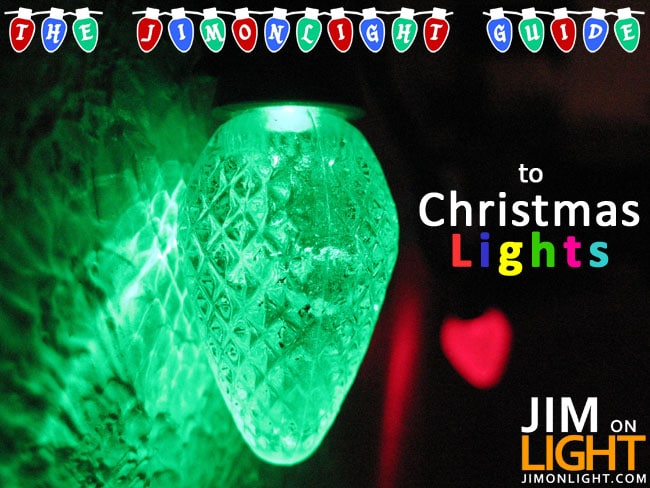
PART ONE:
Christmas Light History
Call them what you want – “holiday” lights, Kwanzaa lights, FSM celebration lights, or just plain Christmas lights – it’s time to load-in your illuminated display and play “whose is bigger” with your neighbors. Every year about this time (and in many, many tacky cases, earlier) we put up lighting around, inside, and attached to our houses to celebrate whatever it is that we celebrate. I’m from central Illinois, so I always associate christmas lights with being freezing cold!
This upcoming weekend seems to be the most popular time of the year to haul out and re-install your grand christmas lighting display. There are many conflicting ideas as to when is appropriate to put up your christmas lights: some people say no earlier than December 1, and some people say that Black Friday (the day after Thanksgiving) is acceptable. Frankly, I could care less – put them up whenever you would like. Just be forewarned that if you leave them up too long after the Christmas holiday, people are probably gonna make fun of you behind your back!
When you go to buy your christmas lights and associated gack that is needed for your display (extension cables, cube taps and power strips, etc), you’re going to be inundated with sizes, shapes, colors (of both lamps and wire), and stuff to attach the lighting to the side of your house. It’s a production. Make sure that you’re ready before you start into the task, you know? It’s like the phrase, “never plumb when the stores are closed.”
The History of Christmas Lighting
Have you ever really thought about this before? They had to start somewhere, right?
“Christmas” lighting actually goes back way into the history of ancient civilizations. There wasn’t a sense of Christmas really until the Christians came along with the whole Jesus birth and all. The idea of worshipping the Sun as a god came about, well, when the sun went away each day. Christianity, Hindu, Islam, the ancient Greeks and Romans, etcetera – it’s all based on worshipping the Sun to help the crops grow, heat the earth, provide light, and generally allow everything to stay alive – something that (rumor has it) the ancient civilizations kinda liked.
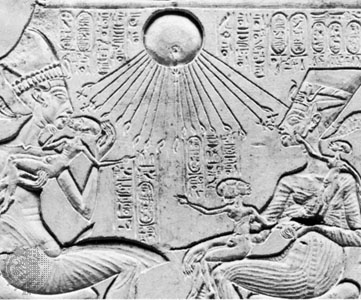
Each year when the winter came, people in ancient times would build fires at night to “lure back” the Sun, which would go “away” earlier and earlier every day that the winter stumbled on. Obviously when you’re cold and ancient, you would probably think “man, I am one cold dude right now. I hope that the Sun comes back tomorrow!” I know I would.
As with Evolutionists and Creationists, there is an alternate version of why Christmas came about, and is based on the winter solstice. Civilizations in ancient history located in the northern hemisphere of earth probably noticed that all year long, the Sun moves south a little more each day during the summer, through autumn, and into the end of the year months. On December 22 of the calendar year, the Sun stops moving south – it actually rises lower and lower in the sky each time it makes its daily appearance. The December 22 date is significant because that day the day that the Sun stops moving south in the sky, and does not move north for December 22, 23, or 24. To ancient civilizations, this symbolized death of the Sun. On December 25, the Sun moves about one degree north, signalling the “rebirth” of the Sun, something to be celebrated, as warmer temperatures, food growing, and not dying of the cold is a good thing.
So, depending on your beliefs, either the Christmas holiday celebrates the alignment of the Sun and foreshadows the spring, or it is a celebration of crucifixion, death, and resurrection of someone named Jesus Christ. Either way, whatever tickles your fancy!

Now, electric christmas lights, on the other hand…

Back when people could only use candles on their trees (you know, because christmas lights hadn’t even been invented), the tree would only get put up in the house for a few days, if that long. It’s that funny way that fire interacts with dry timber that made it hard to really do much but watch the tree to make sure that it wasn’t going to burn down your whole neighborhood.
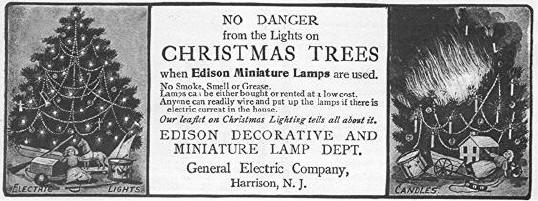
The birth of christmas lights actually goes back very far into history, around the Early Modern Period (1500’s, approximately). Electric christmas lights, on the other hand, were invented by an associate of Tommy Edison back in 1882 – the inventor, Edward Hibberd Johnson, who at the time was the VP of Edison Electric Light Company, had it in his head to hand wire 80 red, white, and blue incandescent lamps about the size of a pinball to a pine tree. Johnson displayed this new invention in his parlor on Fifth Avenue in NYC on the 22nd of December 1882, which made that night the opening night for electric christmas tree lighting and made Johnson the father of the electric christmas tree lights.
A reporter for the Detroit Post and Tribune wrote a review of Johnson’s christmas light display, a historical record of the rockingness of the first christmas lights! Croffut’s review in 1882:
Last evening I walked over beyond Fifth Avenue and called at the residence of Edward H. Johnson, vice-president of Edison’s electric company. There, at the rear of the beautiful parlors, was a large Christmas tree presenting a most picturesque and uncanny aspect. It was brilliantly lighted with many colored globes about as large as an English walnut and was turning some six times a minute on a little pine box. There were eighty lights in all encased in these dainty glass eggs, and about equally divided between white, red and blue. As the tree turned, the colors alternated, all the lamps going out and being relit at every revolution. The result was a continuous twinkling of dancing colors, red, white, blue, white, red, blue—all evening.
I need not tell you that the scintillating evergreen was a pretty sight—one can hardly imagine anything prettier. The ceiling was crossed obliquely with two wires on which hung 28 more of the tiny lights; and all the lights and the fantastic tree itself with its starry fruit were kept going by the slight electric current brought from the main office on a filmy wire. The tree was kept revolving by a little hidden crank below the floor which was turned by electricity. It was a superb exhibition.
Nice. Thanks for inventing christmas lights, Edward! I present you with Edward Johnson’s electric lamp christmas tree:
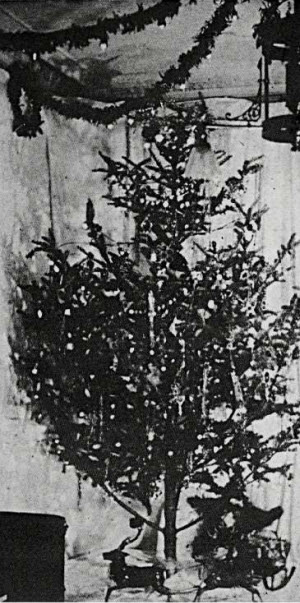
Christmas lights used to come in “crate sets,” which was basically a wooden box with all of the stuff you’d need to set up your lights – the bases, wire, and the lamps. The lamps look lacquer-dipped or some other kind of chemical paint for the glass. Check it out, a version from 1906, made by Empire:

Christmas light lamps got craaaazy in the 1915-1920 era. People made lamps that looked like birds, like policemen, Indians, flowers, pumpkins, and a whole lot more completely random stuff like that. For example, here’s a cut sheet of some package assortments some company was selling:
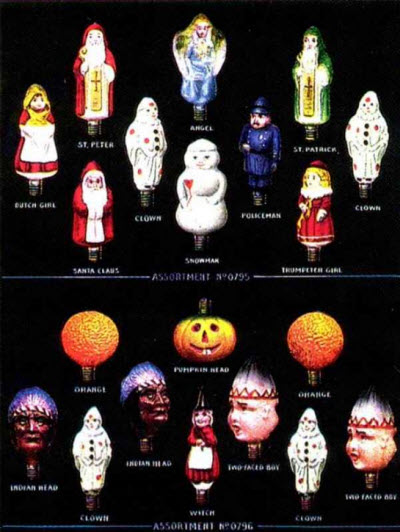
Yep. Pumpkins, Santa, and a witch – what an original combination!
Throughout the 1920’s and 1930’s, figurine and different styles of lamp shapes (round, cones, cones with ribs, etc) were experimented into the market. In the late 1920’s to the Great Depression era, a weird direction took place in the shape of christmas light lamps, at least in my opinion. With the market crashed and people poor everywhere, companies started producing the “matchless star,” which was a crazy looking electric star lamp. Check these out, they’re wild:

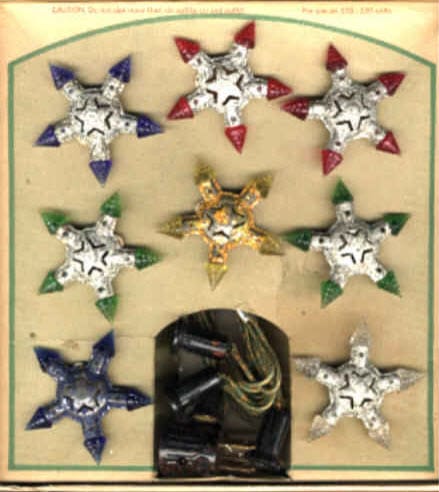
After World War II, in the economic boom that followed, interesting stuff like bubble lamps hit the market, as well as the aluminum christmas tree and those color wheel spotlights that would illuminate the tree from underneath. The bubble lamps look pretty neat – apparently a type of antifreeze type material (methyl something or other) was used in the “bubble chamber” so as to be able to withstand the heat. Here’s a picture of an early bubble lamp, circa-1947:
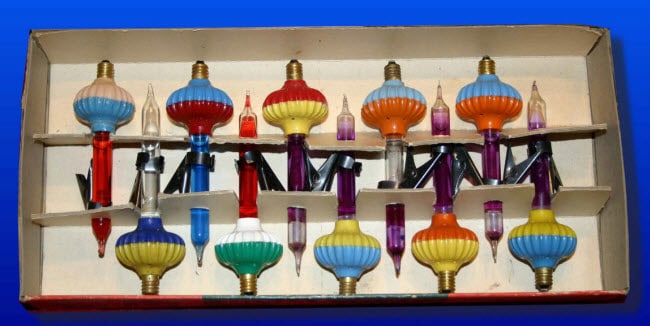
Over the next fifty years all kinds of stuff has happened – manufacturers have come and gone, products have entered and left the market, and progress has changed all kinds of things from the metal in conductors to the efficiency of tungsten filaments. GE, Sylvania, and many others have come out with products like the Lighted Ice lamp (lamp covered with chunks of colored glass), the Tinsel Light (yep, a lamp embedded in tinsel), and the ever-so-popular reflector lamps, which were mini incandescents with little hazy plastic reflectors on each lamp. If you have been alive in the 1900’s at all, your parents probably had thousands of these things over the years. I remember having them as far back as the mid-1990s.
My favorite historical christmas light set is by far the fluorescent christmas lights from Sylvania. How cool! They were essentially cold cathode sources, but they’re white when they’re not energized. Check out these crazy colors:

I totally want some fluorescent christmas lights. I think I might have to make some!
A side note for this post:
I did a lot of research on this five part series, especially the history section. I cannot believe how many resources there are on the internet for christmas light history. Awesome. From the invention of the concept to the way that the business of christmas lighting has progressed over the years, it’s all out there.
You have to see the following websites if you’re interested in the history of christmas lights:
- Timeline of American Christmas Lighting
- MT’s Christmas Lights
- A Brief History of Christmas Lighting in America
Thanks for the great information!
Check out Part Two: Christmas light lamp sizes and types! Exciting!

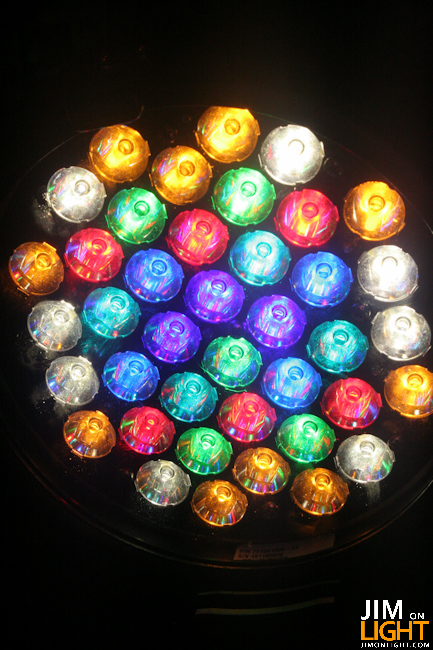



Fantastic article! – (my great grandmother had a bunch of those bubble ornaments. they were my favorite part of her Christmas tree.)
As a little girl in 1947, I remember those original bubble lights on our Christmas tree. i thought they were really special!
Great article, I look forward to the rest of it.
Jim,
I have a story that I thought that you might enjoy. My father Glenn was raised in a family that did not beleive in Christmas. His first Christmas after he married my mom, he went to the general store, laid his week’s pay check in the counter and told the owner of the store to stop him when the amount of the check was spent. Then he started to carry up Christmas decorations and placed them on the counter. Included in his purchases were three things that are still proudly desplayed every one of my 61 Christmas’s. First is a metal tree stand that around the top edge is cut out for a string of lights. Second are the bubble lights which he purchaded to put in the stand. The third are the 2 strings of Royal brand lights which hold the Sylvania fluoresent bulbs. After the years of use the brightness of the bulbs have dimmed but the memories have brightened every time I display them. If you are wanting a set ( NOT MINE) there had been a few sets sold on ebay. I really enjoyed your articalls on the history of Christmas lights. Thank You JOHN
Gizmodo ripped you off: http://gizmodo.com/5425395/christmas-lights-the-brief-and-strangely-interesting-history-of?skyline=true&s=i
Just an fyi they didn’t rip him off they linked to his article. If jim likes traffic getting a link up in Gizmodo is a good thing. They are one of the most read tech blogs around.
Thanks for the comment. Gizmodo has since properly attributed their source. When the comment was left earlier, there was not proper attribution.
Bubble lights are still produced and available. I bought a set for my wife a few weeks ago after she mentioned having liked them as a kid, I’d never heard of them at all. They’re not all over, but not hard to find online.
Nice article, did Gizmodo apologize to you for stealing it? http://gizmodo.com/5425395/christmas-lights-the-brief-and-strangely-interesting-history-of?skyline=true&s=i
I still have my fluorescent christmas lights from Sylvania – I’m in my 60’s and the lights were used on my first christmas tree – I’m so thankful my mother saved them for me !!
WOW! Original fluorescent christmas lights??? That’s excellent. And they still work like a charm? Could you take a picture so I can post it?
Very cool!
I needed to waste a little down time and your article hit the spot! Great research and writing. Merry Christmas!
Thanks for coming to read, Chris! Please come on over any time!
Hey, Jim. I’m doing a National History Day project on Christmas lights, and the two advertisements for ‘Edison Miniature Lamps’ caught my eye. Is it possible for me to get your sources for them?
Comments are closed.